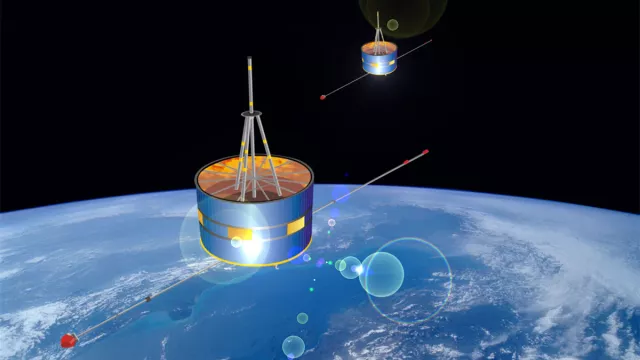For three years, the Chinese Double Star mission studied the interactions between the solar wind and Earth’s magnetosphere. Combined with data from the Cluster mission’s satellites, it has helped to build an unprecedented 3D view of our planet’s magnetic shield.
Key information
| Mission | Etudier les effets du Soleil sur la magnétosphère terrestre |
|---|---|
| Mission | Study how the Sun affects Earth’s magnetosphere |
| Domain | Science |
| Launch date | First launch 29 December 2003 |
| Partners | CNSA (initiator), ESA, LPP, IRAP |
| Where | One satellite in equatorial elliptical orbit, one satellite in polar elliptical orbit |
| Lifetime | Mission ended 30 June 2009 (TC-1 became inoperative on 14 October 2007) |
Key figures
- 2 satellites
- 16 instruments across the 2 satellites
- 7 European instruments across the 2 satellites
- 2 contributing French laboratories
Key milestones
- 14 October 2007: End of TC-1 mission and ESA participation
- 25 July 2004: Launch of TC-2 satellite (Tan Ce 2) by Long March 2C
- 29 December 2003: Launch of TC-1 satellite (Tan Ce 1) by Long March 2C
Project in brief
Double Star was a Chinese mission conducted in partnership with Europe, comprising two satellites—TC-1 in equatorial elliptical orbit and TC-2 in polar elliptical orbit—launched in 2003 and 2004 by a Chinese Long March 2C to study how the Sun affects Earth’s magnetosphere. Until 2007, they operated in tandem with the four satellites of the Cluster mission to probe the key regions of the magnetosphere in depth.
The magnetosphere shields Earth by deflecting most of the stream of particles in the solar wind. However, this shield does let through some solar particles, which generate the magnetic substorms responsible for polar auroras. While the first Double Star satellite in equatorial orbit focused on the tail of Earth’s magnetosphere, where solar particles are accelerated towards the planet’s magnetic poles, the second satellite in polar orbit studied the magnetic poles and polar auroras.
CNES’s role
Double Star carried a payload of 16 instruments, seven from Europe. In France, the LPP plasma physics laboratory (ex-CETP) was involved in designing the STAFF and PEACE instruments, and the IRAP astrophysics and planetology research institute (ex-CESR) the HIA instrument. ESA and CNES funded the European instruments and contributed to data acquisition, as well as coordinating science operations.
Contacts
Sun, Heliosphere & Magnetospheres (SHM) subject matter expert
Kader Amsif
E-mail: kader.amsif at cnes.fr


